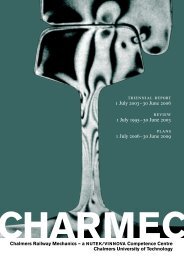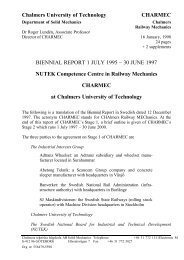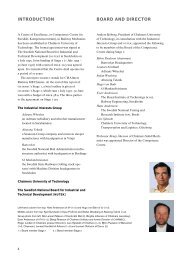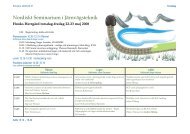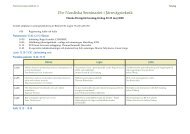You also want an ePaper? Increase the reach of your titles
YUMPU automatically turns print PDFs into web optimized ePapers that Google loves.
Materials and maintenance – Material och underhåll (MU) – Werkstoff und Unterhalt – Matériaux et entretienMU12. CONTACT AND CRACK MECHANICS FOR RAILSKontakt- och sprickmekanik för rälsKontakt- und Rissmechanik für SchienenMécanique de contact et de fissuration des railsProject leaderand supervisorDoctoral candidateProfessor Peter Hansbo,Applied MechanicsMr Per Heintz, MSc(from 2001-11-01;Lic Eng December <strong>2003</strong>)Period 2001-11-01 – <strong>2003</strong>-06-30(– 2006-10-31)Chalmers budget Stage 3: ksek 625(excluding university Stage 4: ksek 1025basic resources)Industrial interests Stage 3: ksek 50in-kind budget (Inexa Profil)Stage 4: ksek 100(voestalpine Bahnsysteme)PhD studentPer Heintz (right)and his supervisorProfessorPeter Hansboin project MU12Numerical (fe) techniques will be developed in the mu12project to predict when and how a predefined crack in arail will grow under given loading conditions. The usualnode-to-segment contact algorithms will be avoided sincethey lack in accuracy and stability. Instead Lagrangemultipliers (stabilized) will be employed to enforce zeropenetration and a balance of forces at the interface. Thispromises to yield accurate contact forces, a factor of utmostimportance in the current railway application. Theoverall aim of the project is (i) to develop new contactalgorithms, (ii) accurately to describe contact forces,(iii) to develop fe techniques to handle crack propagation,and (iv) to establish stand-alone numerical libraries.A project plan dated 2001-01-23 was approved by thecharmec Board on 8 May 2001. The project is partiallyfinanced (50%) by Chalmers Finite Element Center.Numerical methods for goal-oriented adaptive meshrefinement in finite element models have been studiedand implemented. This enables error control in arbitrarymeasurements, e g stresses, shear deformations etc.Adaptive finite element calculations have been carriedout applying Eshelby mechanics (with material forcesenergy conjugated to the propagation of defects in thematerial) as the starting point. It has been shown thatadvanced adaptive methods provide a good way ofensuring the quality of the calculations. A special finiteelement code has been written in fortran 90/95.Two new fe methods for contact between two (ormore) linearly elastic bodies with non-matching gridshave been developed. They share the characteristic ofbeing stable independently of the finite elements used,i e any finite element method can be employed. Themethods have been successfully implemented in the inhousefortran code which is now being extended tohandle three-dimensional problems. This code will alsobe used in the mu11 project and extended to materialmodels pertinent to rail cracking and spalling.Per Heintz gained his degree of Licentiate of Engineeringon 3 December <strong>2003</strong>. At the licentiate seminar,the discussion was introduced by Docent Jonas Niklassonof Chalmers Applied Mechanics.Per Heintz: Adaptive goal-oriented finite element computationof the energy release rate at crack growth, MSc Thesis EX2001:9,Chalmers Applied Mechanics, Gothenburg 2001, 58 ppPer Heintz, Fredrik Larsson, Peter Hansbo and KennethRunesson: On error control and adaptivity for computingmaterial forces in fracture mechanics (invited paper), Proceedings5th World Congress on Computational Mechanics(WCCM V), Vienna (Austria) July 2002, ISBN 3-9501554-0-6,http://wccm.tuwien.ac.at, 10 ppPer Heintz and Klas Samuelsson: On adaptive strategies anderror control in fracture mechanics, Computers & Structures(to appear)Per Heintz, Fredrik Larsson, Peter Hansbo and KennethRunesson: On adaptive strategies and error control for computingmaterial forces in fracture mechanics, InternationalJournal of Numerical Methods in Engineering (to appear)Per Heintz and Peter Hansbo: A stabilized Lagrange multipliermethod for contact phenomena, Proceedings 6th InternationalConference on Contact Mechanics and Wear of Rail/WheelSystems (CM<strong>2003</strong>), Gothenburg June <strong>2003</strong>, vol I, pp 253-257Per Heintz and Peter Hansbo: Consistent and inconsistentLagrange multiplier methods for the finite element solutionof unilateral contact problems using non-matching meshes,Presented at 7th US National Congress on ComputationalMechanics, Albuqerque NM, USA, July <strong>2003</strong>, 1 p (abstract only)Per Heintz and Peter Hansbo: Stabilized Lagrange multipliermethods for elastic contact (submitted to Computer Methodsin Applied Mechanics and Engineering), 12 ppPer Heintz: On computational contact and fracture mechanics,Licentiate Thesis, Chalmers Applied Mechanics, GothenburgDecember <strong>2003</strong>, 70 pp (summary and three appended papers)Example in project MU12 of finite element analysis of frictionlesslinear elastic contact between a vertically loaded circular cylinderand a supporting rectangular block. Note the non-matching grids→42



